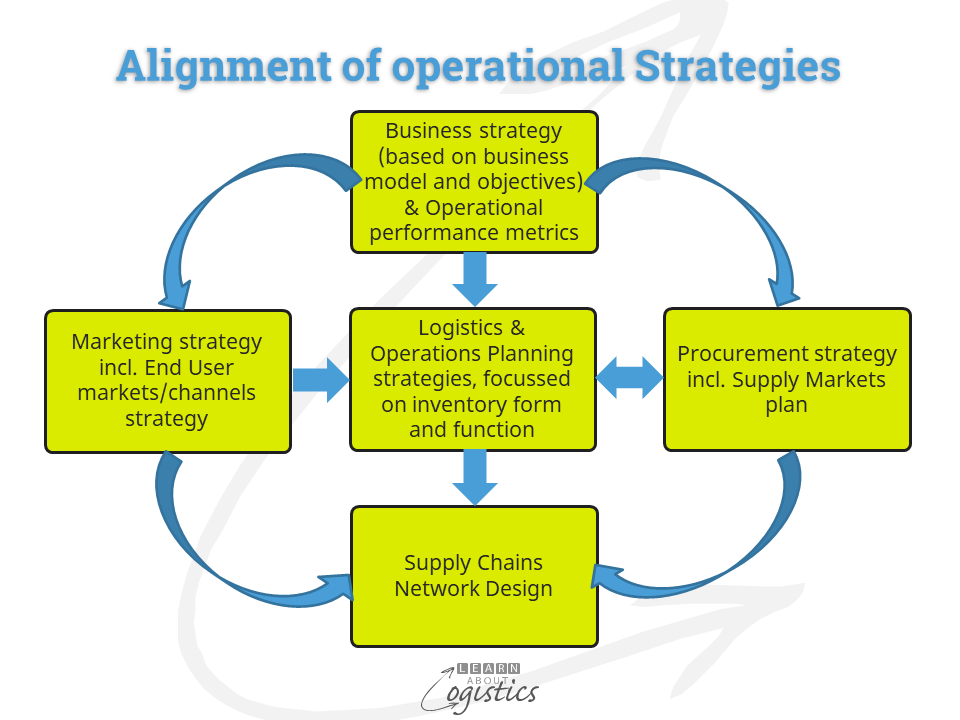Changes in economies and business will happen
The previous blogpost discussed changes that could occur in the global economy, due to forces that influence world trade. Although the list is not definitive, changes will occur that can have an influence on your organisation’s supply chains strategy.
The diagram below shows the alignment necessary between the discipline strategies for each of the organisation’s supply chains. These are the Business strategy, Marketing strategy and the Procurement, Logistics and Operations Planning strategies, which consolidate to form the Supply Chains strategy.

The diagram illustrates that strategies from Marketing and the Supply Chains group provide inputs to the Supply Chains Network Design. This provides a customer-centric view of each supply chain, through addressing customers’ likely demand patterns, provided by Marketing.
The objective of an organisation’s Supply Chains group is to improve customer service through providing Availability of goods and services. But a business with ‘efficient’ approach to supply chains (that is the lowest total cost per sales unit e.g. case or shipper) is less likely to be the most effective. So, while cost reduction is an expected outcome, the focus for the Supply Chains Network Design must be to balance customer service objectives, inventory turns and the Return on Invested Capital (ROIC), as discussed in the eBook Supply Chains Operating Performance.
Are the business strategies understood? Consultants given a brief to identify improvements to the profitability in a business can commence their assignment with an exercise. A group of managers are each given a blank card and asked to write the corporate objectives, then identify the strategies being deployed to achieve the objectives. The returned cards are likely to provide a collection of different objectives (that may not be actuals); strategies which should be objectives and strategies which are tactics. With such an outcome, a well-defined Supply Chains strategy will require co-operation, especially with Marketing.
Changed perspective
Whereas supply chain strategies (if available) for the past twenty years have been mainly based on a ‘low-cost focus’ and cost reduction, scenarios addressing the future are identifying the need for a different perspective. This includes:
- Sustainability of the enterprise through enhanced risk evaluation concerning climate change, emissions reduction in the supply chains and associated government regulations
- Security of supply takes a leading role in supply chain decisions
- Resilience of the enterprise and its supply chains:
- Consider on-shoring, near-shoring, near-sourcing based on the need to reduce volatility between demand and supply
- Increase emphasis on cybersecurity in inter-firm relationships
- Reduce organisation design complexity
- Reduce product complexity and the ‘long tail’ of low selling products
- Reduce process complexity to reduce the ‘cash to cash’ cycle
- Outsourcing decisions based on effectiveness rather than cost
- Reduce time to pay suppliers (accounts payable) to gain supplier commitment
- Reduce emphasis on tax efficient supply chains’ structure
This change in perspective requires:
- policy to be more closely aligned to strategy
- tactics to be more closely aligned to the respective discipline’s policy
For example, the tactics for each supply chain are planned within the Sales & Operations Planning (tactical) process, which is guided by the discipline strategies that consolidate to the supply chains strategy.
Working together
As shown in the diagram above, Marketing and Supply Chains strategies can be developed in parallel. The steps for Marketing to develop its strategy are:
- identify the broad user market as a collection of market segments (current and new)
- identify the segments of most potential for the organisation and
- formulate a strategic approach for each selected segment
Step 1 enables Marketing to differentiate the organisation’s approach within one segment of the market against another segment. Step 3 enables Marketing to identify competitive attributes within a segment – how it considers the organisation can win against competitors. These attributes can often be related to non-product aspects such as service, convenience, delivery and information – all connected with Supply Chains. The totality of attributes is summarised to provide the positioning that Marketing considers will provide competitive differentiation.
So, each market segment has different customer needs, which must be translated into Logistics requirements. This uses the concept of ‘order qualifiers and winners’, a technique developed to provide the bridge between Marketing and Logistics:
- Order qualifiers are those factors that a market segment regards as the base performance requirement to be considered for a customer order.
- Order winners are the factors that are significant enough to win orders for products within a market segment.
There can be a situation where a business sells a range of products that fall into more than one manufacturing process. For example, a Make to Stock (MTS) item will be a standard product, with relatively consistent sales pattern and competitive pricing. Compare this to a Make to Order (MTO) item that has non-standard configurations, an irregular sales pattern and a premium price.
So, the product order qualifiers and winners will differ and so will the Logistics strategies, while many of the input materials could be the same, influencing the Procurement strategy. The Marketing objectives need to be placed within Logistics priorities – for example: speed, quality of the process, flexible, dependable or cost. However, these attributes can be constrained by the ease of handling and storage for the items and where in the supply chain the organisation is positioned.
As order qualifiers and winners change over time, Marketing and the Supply Chains group (or the separate disciplines) must realign strategies in response to changing phases through product life cycles and to anticipate industry or market trends. So, it is not sufficient to align your organisation’s brands only with Marketing.
Brands and reputation are built across an organisation, supported by the breadth of products offered across market segments, manufacturing processes and distribution channels. In addition are the supply chain relationships built with suppliers (including 3PLs and other LSPs) and customers.
So, a brand is more than something Marketing develops. It is a collection of experiences and associations connected with a product or service, which includes the Supply Chain experience. So, are successful brands driven by Marketing and the Supply Chains group working together?


2 Comments on “Build close strategies for Marketing and Supply Chains”
I am a law student who is just curious and hope to venture into this field in the future. I must admit, I have zero knowledge in this particular area of study. Would you possible help, I will provide my email in the prescribed area below
As supply chains are global, a degree in law can be a useful entry qualification, especially in a multi-national company. The Learn About Logistics website provides learning materials that can help students understand the concepts surrounding supply chains. This knowledge can assist in interviews for jobs in supply chains. Questions about the topics are welcome, as the answers can assist other students in the same situation. All the best for your future career.